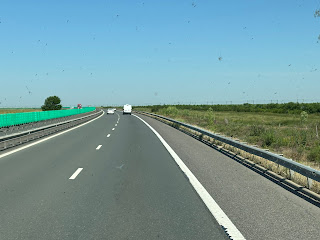The M.S. River Adagio is our home no more. We packed up and left the ship this morning and spent the next several hours on a bus, going back the way we came on the boat. We even crossed the Danube three times on the highway, seeing places we had just been the day before.
The motorway was in better condition than a lot of Interstate highways in the U.S. It's a toll road, but all tolls are collected electronically so we had no stops for that.
The terrain when we left Constanta was rolling hills. It looked a lot like Iowa or Minnesota. But shortly after our second crossing of the Danube - Black Sea Canal the land became tabletop flat. The fields are huge and there are no farmsteads. Farmers drive equipment from towns.
At a rest stop we encountered a Roma ("gypsy") woman who had parked her horse and wagon among the wild poppies that line the road.
We arrived in Bucharest in time for lunch. Our tour director told us that we were nearly there and to get ready to leave the bus. Then we inched our way through heavy traffic on city streets for another 45 minutes. All three of the other buses with Adagio passengers arrived ahead of us. We wonder if our driver was lost.
Lunch was very good. And as soon as it was finished we met our local guide and got back on the bus for a city tour. Big meal, hot day, warm bus -- the guide wasn't bad, but we couldn't stay awake.
We stopped in Revolution Square, across the street from the Presidential Palace, where we met a Romanian man who participated in the demonstrations that led to the ouster of Romanian dictator Nicolae Ceaușescu in 1989.
We continued on to the Parliamentary Palace -- the second largest building in the world, after the Pentagon in Washington, D.C.
This huge building -- which Ceaușescu nearly bankrupted the country constructing -- is not sufficient to house the entire government and bureaucracy of little Romania. There are more government office buildings lining the avenue that leads to it.
Bucharest still bears the marks of its communist past, but with a lot more fresh paint, tree-line boulevards, and nicely restored older buildings than cities in some of the other countries we've visited. It was known as "the Paris of the East" in its pre-communist days, and that classy history shines through, too.
After checking into the hotel our tour leader took us for a walking orientation of the neighborhood. On his recommendation we visited a bakery that specializes in French-style eclairs. They were a bit pricey, but very good.
Then we went to a grocery store and bought cheese sandwiches for dinner. Nothing like having dessert first! But the sandwiches were also quite good, and incredibly cheap.









No comments:
Post a Comment